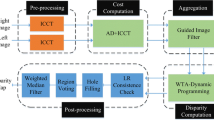Abstract
In this paper, we propose a dense stereo algorithm based on the census transform and improved dynamic programming (DP). Traditional scanline-based DP algorithms are the most efficient ones among global algorithms, but are well-known to be affected by the streak effect. To solve this problem, we improve the traditional three-state DP algorithm by taking advantage of an extended version of sequential vertical consistency constraint. Using this method, we increase the accuracy of the disparity map greatly. Optimizations have been made so that the computational cost is only increased by about 20%, and the additional memory needed for the improvement is negligible. Experimental results show that our algorithm outperforms many state-of-the-art algorithms with similar efficiency on Middlebury College’s stereo Web site. Besides, the algorithm is robust enough for image pairs with utterly different contrasts by using of census transform as the basic match metric.
Similar content being viewed by others
References
Baker, H.H., Binford, T.O.: Depth from edge and intensity based stereo. In: Proc. Int. Joint Conf. on Artificial Intelligence, vol. 2, pp. 631–636. William Kaufmann, Vancouver, Canada (1981)
Barnard, S.T.: Stochastic stereo matching over scale. Int. J. Comput. Vis. 3, 17–32 (1989)
Birchfield, S., Tomasi, C.: Depth discontinuities by pixel-to-pixel stereo. In: Proceedings of IEEE Int. Conf. on Computer Vision, pp. 1073–1080. IEEE Comput. Soc. Press, Kerkyra, Greece (1998)
Bobick, A.F., Intille, S.S.: Large occlusion stereo. Int. J. Comput. Vis. 33(3), 181–200 (1999)
Boykov, Y., Veksler, O., Zabih, R.: Fast approximate energy minimization via graph cuts. IEEE Trans. Pattern Machine Intell. 23(11), 1222–1239 (2001)
Brown, M.Z., Burschka, D., Hager, G.D.: Advances in computational stereo. IEEE Trans. Pattern Anal. Machine Intell. 25(8), 993–1008 (2003)
Canny, J.: A computational approach to edge detection. IEEE Trans. Pattern Machine Intell. 8(6), 679–697 (1986)
Cormen, T.H., Leiserson, C.E., Rivest, R.L.: Introduction to Algorithms. McGraw-Hill, New York (1990)
Cox, I.J., Hingorani, S.L., Rao, S.B., Maggs, B.M.: A maximum likelihood stereo algorithm. Comput. Vis. Image Understanding 63(3), 542–567 (1996)
Faugeras, O., Hotz, B., Mathieu, H., Viéville, T., Zhang, Z., Fua, P., Théron, E., Moll, L., Berry, G., Vuillemin, J., Bertin, P., Proy, C.: Real Time Correlation Based Stereo: Algorithm Implementations and Applications. INRIA Research Report 2013 (1993)
Geman, S., Geman, D.: Stochastic relaxation, bibbs distributions, and the bayesian restoration of images. IEEE Trans. Pattern Anal. Machine Intell. 6(6), 721–741 (1984)
Gong, M., Yang, Y.-H.: Near real-time reliable stereo matching using programmable graphics hardware. IEEE Proc. Comput. Vis. Pattern Recognition 1, 924–931 (2005)
Hirschmüller, H.: Improvements in real-time correlation-based stereo vision. In: Workshop on Stereo and Multi-Baseline Vision, pp. 141–148 (2001)
Hirschmüller, H.: Accurate and efficient stereo processing by semi-global matching and mutual information. IEEE Proc. Comput. Vis. Pattern Recognition 2, 807–814 (2005)
Kanade, T., Okutomi, M.: A stereo matching algorithm with an adaptive window: theory and experiment. IEEE Trans. Pattern Anal. Machine Intell. 16(9), 920–932 (1994)
Kim, J., Kolmogorov, V., Zabih, R.: Visual correspondence using energy minimization and mutual information. In: Int. Conf. Computer Vision, pp. 1033–1040. IEEE Comput. Soc. Press, Nice, France (2003)
Leclercq, P.: Stereo Matching Algorithms. PhD thesis. University of Western Australia (2003)
Mordohai, P., Medioni, G.: Stereo using monocular cues within the tensor voting framework. IEEE Trans. Pattern Anal. Machine Intell. 28(6), 968–982 (2006)
Ogale, A.S., Aloimonos, Y.: Robust contrast invariant stereo correspondence. In: IEEE Int. Conf. Robotics and Automation, pp. 819–824. IEEE Comput. Soc. Press, Barcelona, Spain (2005)
Scharstein, D., Szeliski, R.: A taxonomy and evaluation of dense two-frame stereo correspondence algorithms. Int. J. Comput. Vis. 47(1–3), 7–42 (2002)
Scharstein, D., Szeliski, R.: Middlebury Stereo Vision Research Page. (URL http://www.middlebury.edu/stereo)
Sun, J., Shum, H.Y., Zheng, N.N.: Stereo matching using belief propagation. IEEE Trans. Pattern Machine Intell. 25(7), 787–800 (2003)
Szeliski, R.: Bayesian modeling of uncertainty in low-level vision. Int. J. Comput. Vis. 5(3), 271–302 (1990)
The Aggregate Magic Algorithms. (URL http://aggregate.org/MAGIC/)
Veksler, O.: Fast variable window for stereo correspondence using integral images. In: IEEE Proc. Computer Vision and Pattern Recognition, vol. 1, pp. 556–561. IEEE Comput. Soc. Press, Madison, WI, USA (2003)
Yang, Q., Wang, L., Yang, R., Wang, S., Liao, M., Nistér, D.: Real-time global stereo matching using hierarchical belief propagation. In: Proc. British Machine Vision Association, p. III: 989 (2006)
Yoon, K.-J., Kweon, I.-S.: Locally adaptive support-weight approach for visual correspondence search. In: IEEE Proc. Computer Vision and Pattern Recognition, vol. 2, pp. 924–931. IEEE Comput. Soc. Press, San Diego, CA, USA (2005)
Zabih, R., Woodfill, J.: Non-parametric local transforms for computing visual correspondence. In: Proc. Third European Conf. Computer Vision, Lect. Notes Comput. Sci., vol. 2, pp. 151–158. Springer, Stockholm, Sweden (1994)
Author information
Authors and Affiliations
Corresponding author
Rights and permissions
About this article
Cite this article
Xu, Z., Ma, L., Kimachi, M. et al. Efficient contrast invariant stereo correspondence using dynamic programming with vertical constraint. Visual Comput 24, 45–55 (2008). https://doi.org/10.1007/s00371-007-0177-9
Published:
Issue Date:
DOI: https://doi.org/10.1007/s00371-007-0177-9




